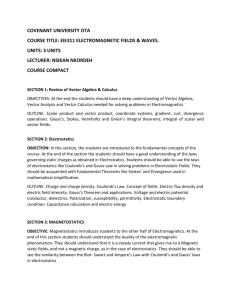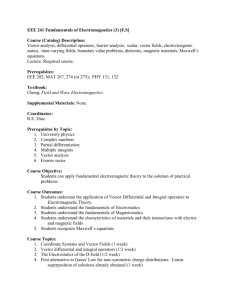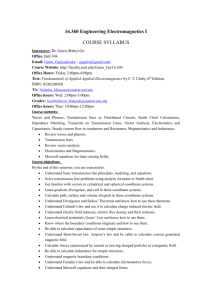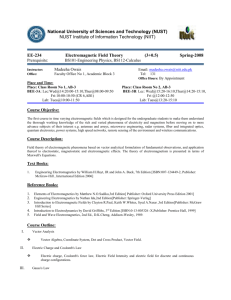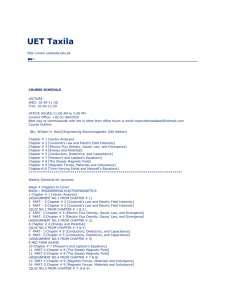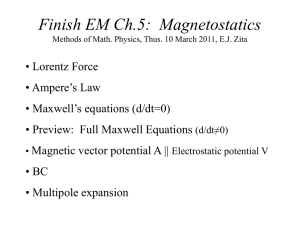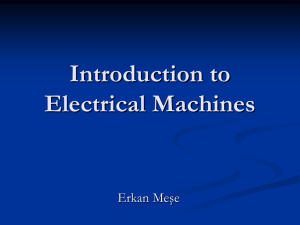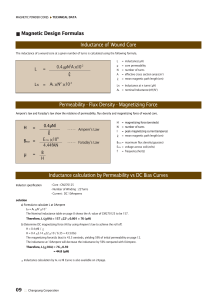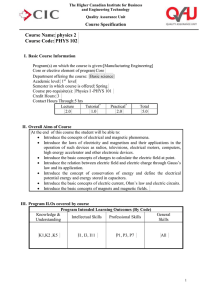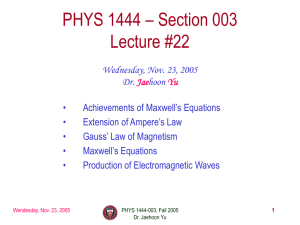Outline - UMT Admin Panel
advertisement
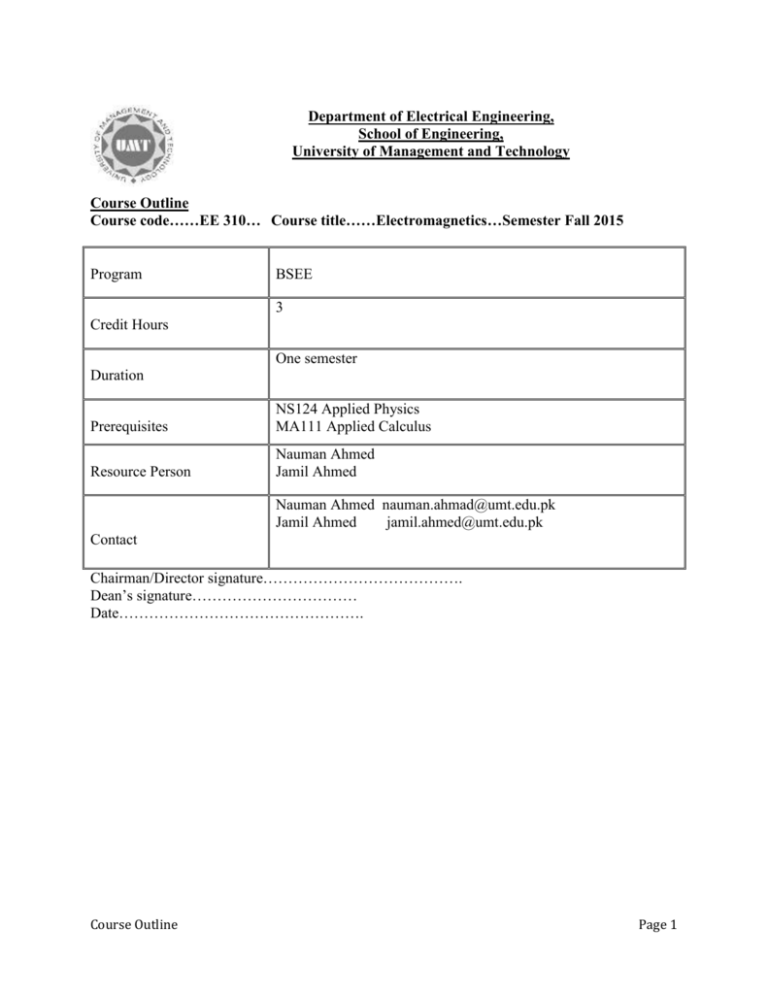
Department of Electrical Engineering, School of Engineering, University of Management and Technology Course Outline Course code……EE 310… Course title……Electromagnetics…Semester Fall 2015 Program BSEE 3 Credit Hours One semester Duration Prerequisites NS124 Applied Physics MA111 Applied Calculus Resource Person Nauman Ahmed Jamil Ahmed Nauman Ahmed nauman.ahmad@umt.edu.pk Jamil Ahmed jamil.ahmed@umt.edu.pk Contact Chairman/Director signature…………………………………. Dean’s signature…………………………… Date…………………………………………. Course Outline Page 1 Learning Objectives: This course deals with the fundamental concepts of electromagnetic theory. The emphasis is made on physical understanding and practical applications in Electrical systems. It covers the study of Electric field concepts, Gauss’s Law, Divergence, energy and potential, current in conductors, dielectrics, capacitance, Laplace and Poisson’s equations, steady magnetic field and study of laws like Bio-Savart Law, ampere’s circuital law, magnetic forces, materials and inductance, time varying fields and Maxwell’s equations. Student Learning Outcomes: In accordance with HEC recommended outcomes a, b , c, d and e following are the expected outcomes for this course. Obtain a comprehensive understanding of fundamental concepts in static electric and magnetic fields. Know about fundamental laws of electromagnetic. Be familiar with different vector operators. Be able to apply Gauss’s law, Ampere’s law, Biot-Savart law, and Maxwell’s equations in electromagnetic systems. Be familiar with four Maxwell’s equations 1. Be able to apply electromagnetic boundary conditions to solve for fields at different mediums. Learning Methodology: Lecture, interactive, participative, EDA tools and Computer Simulations. Grade Evaluation Criteria Following is the criteria for the distribution of marks to evaluate final grade in a semester Marks Evaluation Marks in percentage Quizzes and Assignments 25 Mid Term 25 Final exam 50 Total 100 Recommended Text Books: Engineering Electromagnetics, 7th edition, by William H. Hayt and John A. Buck, McGraw Hill. Reference Book: Field and wave Electromagnetics by David K. Cheng, 2nd edition. Sadiku, Matthew N, “Elements of Electromagnetics”, Oxford University Press, ISBN: 0195103688, Third Edition. Course Outline Page 2 Course Schedule Lecture Topics Textbook (TB) /Reference (Ref) Readings 1.1 – 1.9 1–4 Vector algebra, rectangular, cylindrical and spherical coordinate systems. 5–7 TB 2.1 – 2.6 Coulomb’s law, electric field due to different charge distributions. TB 3.1 – 3.7 8-11 12-15 Week 8 Electric flux density, Gauss’s law and applications, Maxwell’s first equation, vector operator and divergence TB Energy expanded in moving a point charge, line integral, potential difference, potential field of a point charge and system of charges, potential gradient, dipole, energy density in electrostatic field 4.1 – 4.8 Midterm Midterm TB 8.1 – 8.7 18-21 Biot-Savart law, Ampere’s law, curl, Stoke’s theorem, magnetic flux and flux density, scalar and vector magnetic potentials, derivation of steady magnetic field laws TB 9.1 – 9.6 22-25 Force on a moving charge, force on a differential current element, force between differential current elements, force and torque on a closed circuit, nature of magnetic materials and magnetic boundary conditions, magnetic circuits, inductance and mutual inductance TB 5.1 – 5.6 26-27 Current density, continuity of current, metallic conductors, boundary conditions, method of images TB 6.1 – 6.3 28-30 Dielectric materials, perfect dielectric materials and boundary conditions, capacitance and examples Course Outline TB Page 3


